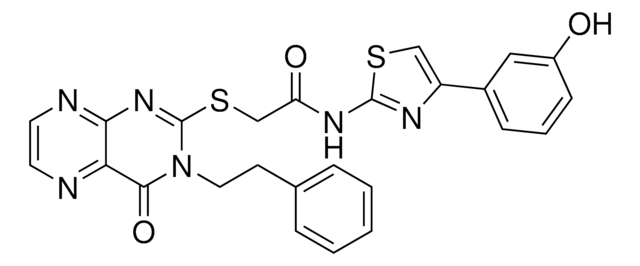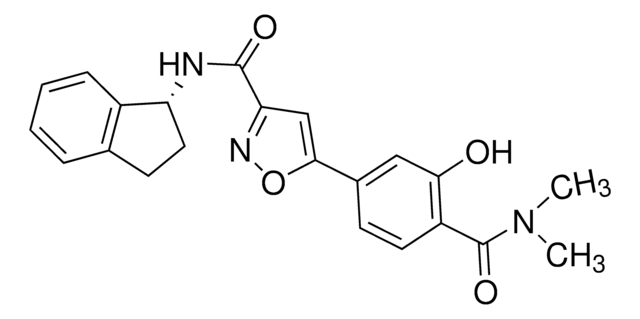おすすめの製品
品質水準
アッセイ
≥98% (HPLC)
形状
powder
色
white to beige
溶解性
DMSO: 2 mg/mL, clear
保管温度
−20°C
InChI
1S/C23H26N6O2/c1-18-5-4-6-19(15-18)17-25-28-21-16-22(29-10-13-30-14-11-29)27-23(26-21)31-12-8-20-7-2-3-9-24-20/h2-7,9,15-17H,8,10-14H2,1H3,(H,26,27,28)/b25-17+
InChI Key
HSKAZIJJKRAJAV-KOEQRZSOSA-N
生物化学的/生理学的作用
Apilimod (STA-5326) is a potent, orally active and selective inhibitor of the cytokines IL-12 and IL-23. Apilimod selectively suppresses synthesis of IL-12 and IL-23 by inhibition of phosphotransferase activity of TLR-4 regulator lipid kinase PIKfyve (phosphatidylinositol-3-phosphate 5-kinase). It suppresses Th1 cells response in vivo and reduces inflammatory histopathologic changes. Also, it exhibits strong anti COVID-19 activity in two cell lines (Vero E6:IC50 < 0.08 μM; A549-ACE2:IC50 = 0.007 μM). Apilimod potently reduces entry of SARS-CoV S pseudovirions on 293/hACE2 cells.
保管分類コード
11 - Combustible Solids
WGK
WGK 3
引火点(°F)
Not applicable
引火点(℃)
Not applicable
適用法令
試験研究用途を考慮した関連法令を主に挙げております。化学物質以外については、一部の情報のみ提供しています。 製品を安全かつ合法的に使用することは、使用者の義務です。最新情報により修正される場合があります。WEBの反映には時間を要することがあるため、適宜SDSをご参照ください。
Jan Code
SML2974-25MG:
SML2974-VAR:
SML2974-5MG:
SML2974-BULK:
試験成績書(COA)
製品のロット番号・バッチ番号を入力して、試験成績書(COA) を検索できます。ロット番号・バッチ番号は、製品ラベルに「Lot」または「Batch」に続いて記載されています。
Xinming Cai et al.
Chemistry & biology, 20(7), 912-921 (2013-07-31)
Toll-like receptor (TLR) signaling is a key component of innate immunity. Aberrant TLR activation leads to immune disorders via dysregulation of cytokine production, such as IL-12/IL-23. Herein, we identify and characterize PIKfyve, a lipid kinase, as a critical player in
Xiuyuan Ou et al.
Nature communications, 11(1), 1620-1620 (2020-03-30)
Since 2002, beta coronaviruses (CoV) have caused three zoonotic outbreaks, SARS-CoV in 2002-2003, MERS-CoV in 2012, and the newly emerged SARS-CoV-2 in late 2019. However, little is currently known about the biology of SARS-CoV-2. Here, using SARS-CoV-2 S protein pseudovirus
Mehdi Bouhaddou et al.
Cell, 182(3), 685-712 (2020-07-10)
The causative agent of the coronavirus disease 2019 (COVID-19) pandemic, severe acute respiratory syndrome coronavirus 2 (SARS-CoV-2), has infected millions and killed hundreds of thousands of people worldwide, highlighting an urgent need to develop antiviral therapies. Here we present a
ライフサイエンス、有機合成、材料科学、クロマトグラフィー、分析など、あらゆる分野の研究に経験のあるメンバーがおります。.
製品に関するお問い合わせはこちら(テクニカルサービス)








